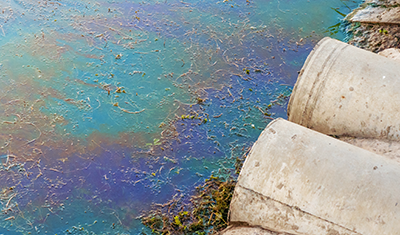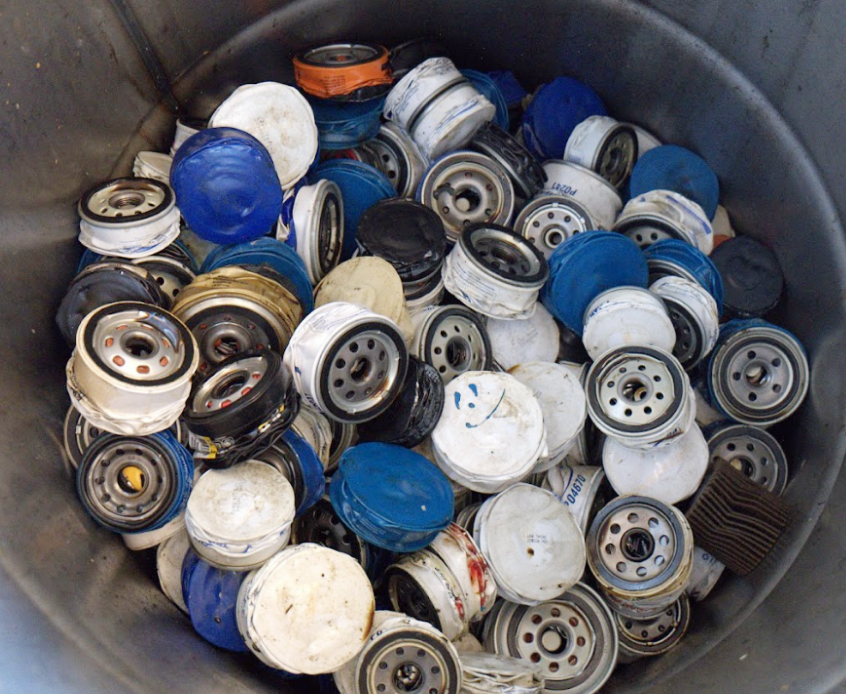P2 Section #2 | Automotive Maintenance - Pg 3

Section 2 | Used Oil
Revised On: Feb. 25, 2024 - 9:00 a.m.
Learning Objectives:
- Identify sources of used oil and harmful pollutants
- Identify the impact of used oil on the environment and human health
- Minimize used oil waste through best management practices
- Determine additional P2 opportunities to reduce used oil waste.
Oil is another commonly regulated fluid encountered within automotive maintenance. It is present in many parts of the vehicle, which are all purposely formulated to work well within that portion. Car oils keep parts lubricated, act as a hydraulic fluid, regulate temperature, internally clean, and protect against corrosion. The oil is constantly being moved, pressurized, heated, and cooled while in contact with all of the metal parts within the vehicle and any outside contaminants that find their way in. This creates used oil.

Used oil is classified as a regulated substance, the definition of which specifies that it must be any oil that has been refined from crude oil or any synthetic oil that is no longer fit for its intended purpose due to physical or chemical impurities caused by use, handling, transportation, or storage. Effective management and disposal of used oil are essential to prevent any negative impacts on both the environment and human health. Let’s first review a few different sources that you may encounter in your facility:
Engine Oil
Engine oil is the most commonly encountered automotive oil for maintenance. This is due to engine oil always being in the harshest conditions of the car. Engine oil undergoes high pressure and high-temperature conditions from combustion, which also leaves behind contaminants that are picked up by the oil. Exposure to heat, oxygen, and contaminants can cause oil oxidation, leading to the formation of sludge, varnish, and acids. Oxidation reduces the oil's effectiveness and can contribute to equipment wear and failure. Even without oxidation, contaminants affect the efficiency of the oil and will ultimately damage the engine through sludge buildup when the oil can no longer remove the contaminants.
The contaminants in engine oil may be dirt, water, heavy metals, carbon, and polycyclic aromatic hydrocarbons (PAHs). PAHs primarily come from the gasoline present in the engine for combustion. Heavy metals, such as nickel and lead, may go directly from the engine components, fuel additives, or the fuel itself. Many of these contaminants will also be found in the oil filters. Engine oils will also usually contain additives to help prolong their lifespan. Additives present in the used oil, such as detergents, dispersants, antioxidants, and anti-wear agents, can deplete over time and use. Additive depletion can further degrade the oil's performance and protective properties.
Transmission Fluid
Transmission fluid is a specialized fluid that serves multiple functions within an automatic transmission system. This fluid provides lubrication, which reduces friction and acts as a coolant. Additionally, it acts as a hydraulic fluid, enabling the transmission to shift gears smoothly. There are two main types of transmission fluids:
- Automatic Transmission Fluid (ATF): Used in automatic transmissions, ATF is available in various formulations, including conventional, synthetic, and high-performance options.
- Manual Transmission Fluid (MTF): Used in manual transmissions, MTF is specifically designed to meet the needs of manual gearboxes.
Transmission fluids are formulated to provide specific viscosity and friction properties suitable for the transmission type. Transmission fluid must be replaced far less often than engine oil due to the absence of combustion and fuel. The wear and tear of the metal components can still contribute to the contamination of the transmission fluid and the generated heat. There is also the risk of coolant contaminating the transmission fluid if there is a leak within the radiator.
Power Steering Fluid
 Power steering fluid is used in hydraulic power steering systems to transmit hydraulic pressure, allowing the driver to steer the vehicle easily. Power steering fluid may not be present in a car depending on the type of power steering system:
Power steering fluid is used in hydraulic power steering systems to transmit hydraulic pressure, allowing the driver to steer the vehicle easily. Power steering fluid may not be present in a car depending on the type of power steering system:
- Hydraulic Power Steering Fluid: Used in traditional hydraulic power steering systems, which rely on hydraulic pressure to assist with steering.
- Electric Power Steering (EPS) Fluid: Electric power steering systems do not use hydraulic fluid but rely on an electric motor. Therefore, no power steering fluid is required for EPS systems.
The frequency of this fluid being replaced and the reason for contamination is similar to that of transmission fluid.
Environmental and Human Health Concerns
Once oils are drained from vehicles, they become used oil as they are no longer suitable for their intended use. As mentioned above, used oil contains various toxic substances, such as heavy metals and PAHs. In addition, the oil itself can be problematic due to being insoluble and persistent. This means it does not readily degrade in the environment and will continue accumulating if left untreated.
The effects on land and water environments can be destructive in various ways. When used oil enters water bodies through runoff, spills, or improper disposal, it can contaminate rivers, lakes, streams, and groundwater, threatening aquatic ecosystems and water quality. Oil in these water bodies will cause a film to develop on the water's surface, which can prevent sunlight and reduce oxygen levels within the water. Oil-contaminating soil prevents the growth of plants or the use of the land for agriculture. Oil can also stick to wildlife and cause adverse health effects. Oil-coated animals may suffer from reduced buoyancy, impaired thermoregulation, and ingestion of toxic substances, leading to injuries and fatalities. These situations can then impact food supplies and habitats of the local wildlife.

When looking at the effects of human health, the contamination of water bodies can result in the loss of valuable drinking water. If such water is ingested, it can cause various stomach issues, such as nausea, vomiting, and diarrhea. To avoid any accidental ingestion through cross-contamination, always wash your hands properly, and do not eat, drink, or smoke while working with these fluids. Wash your hands thoroughly after handling them. There are additional health effects to consider, such as:
- Skin irritation, redness, and dermatitis from direct contact
- Respiratory irritation from inhalation of oil mists, vapors, or fumes
- Exposure to certain chemicals in used oil, such as benzene, may increase the risk of reproductive issues and birth defects in individuals of childbearing age.
This is why it’s always essential to use proper PPE to protect yourself when handling these substances. This includes gloves, eye protection, and working in a well-ventilated area. Any sign of these symptoms should be taken seriously, and proper medical care should be sought.
Management of Used Oil
Used oil comes with certain management standards, including storage and disposal. For storage:
- Used oil must be stored in containers or tanks.
- Containers and tanks must be labeled as “Used Oil.”
- No rust, leaks, or deterioration can occur on tanks and containers. They must be in good condition.

A container is any portable device in which a material is stored, transported, treated, disposed of, or otherwise handled. A tank is similar to this but is a stationary device designed to contain an accumulation of used oil that is constructed primarily of non-earthen materials (e.g., wood concrete, steel, plastic), which provides structural support. These definitions both come from 40 CFR Part 279.
If used oil is released, then the following steps must be performed:
- Stop the release
- Contains the released used oil
- Clean up and manage properly the released used oil and other materials
If necessary, repair or replace any leaking used oil storage containers or tanks before returning them to service.
- Depending on the amount, there are some options for disposing of the used oil. One option is to use a transporter that has obtained an EPA identification number. If you are dealing with small amounts of used oil generated at your site, you can self-transport the used oil to a collection center. There are a few conditions that need to be met:
- The used oil must be transported in an employee or generator-owned vehicle
- No more than 55 gallons of used oil can be transported at any time
The used oil must be transported to a used oil collection center registered, licensed, permitted, or recognized by a state/county/municipal government to manage used oil.
You can contact ADEQ to find an approved collection center for transporting used oil.
P2 Opportunities
Used oil is a difficult waste stream to try to reduce as it depends on how many applicable services are performed in a day. There are still opportunities available to reduce the amount of waste generated and reduce the source.
- Buy oil from suppliers that re-refine used oil. The amount of energy it takes to process used oil to a usable state is much less than that of producing more of that oil. The oil itself is separated from the contaminants that we covered until the used oil returns to a state that is as clean as when bought. There are minimal losses in oil through this process.
- Avoid mixing used oil waste with any other type of waste. This ensures the used oil can be managed as used oil and prevents unnecessary increases in the amount of waste needing management and disposal.
- Spill and Leak prevention is vital to reduce unnecessary environmental and human harm. Regularly inspect used oil containers and equipment such as drip pans. Take precautions about where used oil is placed to minimize accidents, and immediately move any drained oil to its appropriate container. Secondary containment to control any spills/leaks is also recommended.
- Reusable oil filters reduce the amount of waste associated with draining and disposing of single-use filters. These reusable oil filters can be stocked and offered to customers for purchase when getting an oil change. A parts washer will be needed on-site to clean reusable oil filters.
In the next lesson, we will talk about other automotive fluids.
GUIDES
Implementing P2 > | Spanish >
Inventory Control > | Spanish >
Solvent-Contaminated Wipes >
Used Oil >
Waste Determination >
POSTERS
Clear Walkways > | Spanish >
Clean Workspace > | Spanish >
First-In, First-Out > | Spanish >
Use & Stow > | Spanish >
VIDEOS
Auto Shop Housekeeping>
FIFO for Auto Shops >
What is P2 >
OTHER
P2 in Action >
